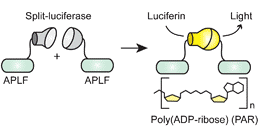Department of Chemistry
ORCID IDs
Document Type
Article
Date of this Version
2010
Abstract
The direct detection of native proteins in heterogeneous solutions remains a challenging problem. Standard methodologies rely on a separation step to circumvent nonspecific signal generation. We hypothesized that a simple and general method for the detection of native proteins in solution could be achieved through ternary complexation, where the conditional signal generation afforded by split-protein reporters could be married to the specificity afforded by either native receptors or specific antibodies. Toward this goal, we describe a solution phase split-luciferase assay for native protein detection, where we fused fragmented halves of firefly luciferase to separate receptor fragments or single-chain antibodies, allowing for conditional luciferase complementation in the presence of several biologically significant protein targets. To demonstrate the utility of this strategy, we have developed and validated assay platforms for the vascular endothelial growth factor, the gp120 coat protein from HIV-1, and the human epidermal growth factor receptor 2 (HER2), a marker for breast cancer. The specificities of the recognition elements, CD4 and the 17b single-chain antibody, employed in the gp120 sensor allowed us to parse gp120s from different clades. Our rationally designed HER2 sensing platform was capable of discriminating between HER2 expression levels in several tumor cell lines. In addition, luminescence from reassembled luciferase was linear across a panel of cell lines with increasing HER2 expression. We envision that the proof of principle studies presented herein may allow for the potential detection of a broad range of biological analytes utilizing ternary split-protein systems.
Includes supplementary materials.


Comments
ACS CHEMICAL BIOLOGY VOL.5 NO.10 (2010), pp. 943-952; DOI: 10.1021/cb100143m